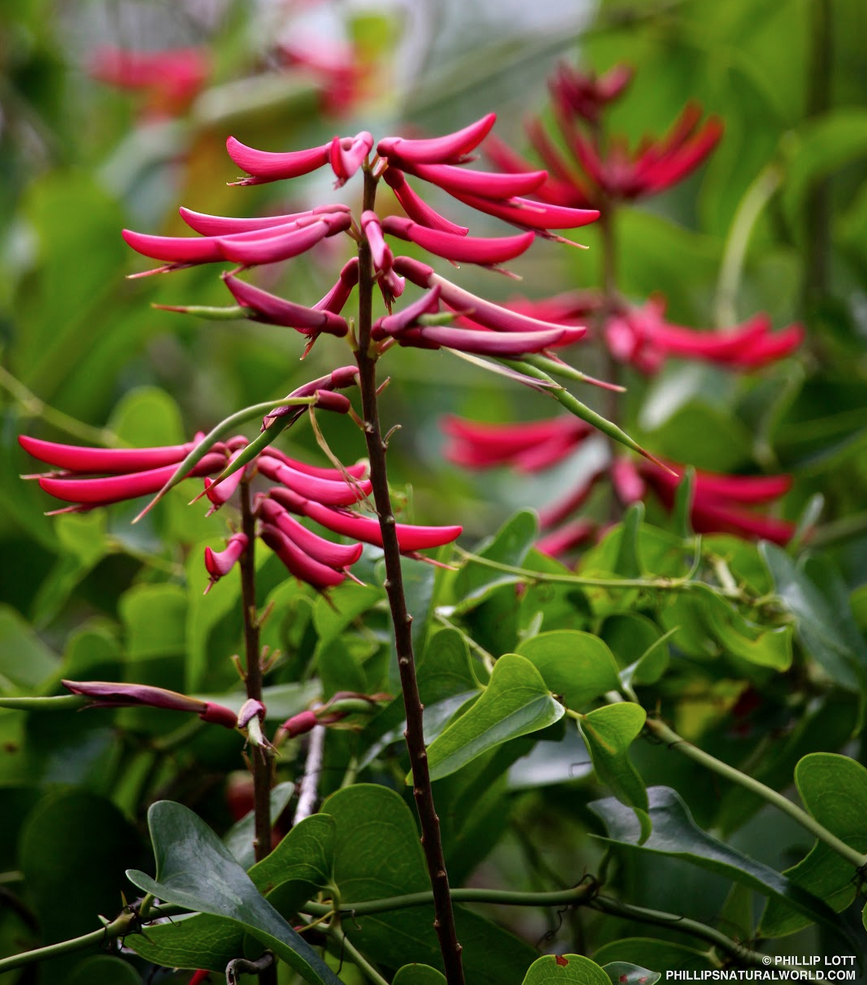
Eastern Coral Bean. Photo by Phillip Lott, PhillipsNaturalWorld.com
Blossoming this time of year is the Eastern Coral Bean, sometimes called the Cherokee Bean. What is odd about this plant is the edible flowers produce toxic beans. So we don’t eat the red and black beans. A few of the red blossoms are edible raw — with precautions — but they are usually boiled then mixed with other foods notably scrambled eggs. When you cook the blossoms they turn light green. The distinctive shape of the leaves makes the shrub easy to identify. Young leaves are edible cooked but are marginal fare. Like the Pawpaws above they prefer dry, sunny places. A few raw red blossoms seem okay but if eaten in larger amounts they can be mind altering and approaching dangerous. Boiled they are fine. (Juice from the shrub’s stems, by the way, has been used to treat scorpion stings.) You can read more about the Eastern Coral Bean here. I have a video about it here.
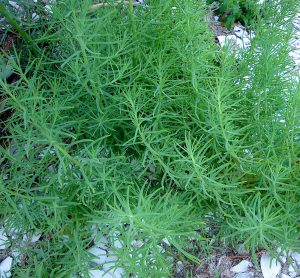
Seablite is my candidate to be a commercial vegetable. It will be around for a few months. Photo by Green Deane
For foragers on the coast Suaeda linearis is in season from Daytona Beach to Port Charlotte, not on the beach side but the intracoastal water ways, river-fed harbors, and brackish water. It’s a great spring time green that has everything going for it except perhaps its name, Seablite. The plant is mild but tasty, has excellent texture, can be eaten raw or cooked though cooked is the usual way. It makes an excellent stuffing when roasting or poaching fish. Seablite is nutritious, stores well, looks good, grows easily in salty ground (read unused land) and even feels good to handle. You can also cultivate it in your garden, far from the sea. It would make an excellent commercial product, perhaps better than other wild foods brought to market. Think of Seablite as a Chinopodium that likes to grow in salty places, either near the ocean or salt licks. It has a high sodium content but boiling reduces that significantly. If you live anywhere near the ocean look for it. If you live inland near salt deposits look for its edible cousin, seepweed. To read about it click on the link above. To see my video go here.
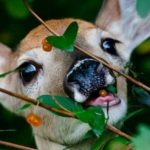 Foraging Classes: When I started writing this newsletter I had four classes scheduled and three of the locations were open. But the governor has shut down the state so all public classes are off. Private classes will be individually considered. I will post next week a schedule of classes for May. For more information about classes go here.
Foraging Classes: When I started writing this newsletter I had four classes scheduled and three of the locations were open. But the governor has shut down the state so all public classes are off. Private classes will be individually considered. I will post next week a schedule of classes for May. For more information about classes go here.
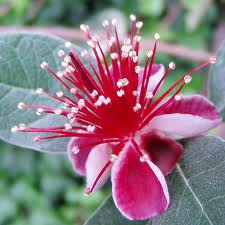
Pineapple Guava Blossom.
Perhaps no ornamental was championed as much as the Pineapple Guava. However the perfect shrub for many places never really caught on. There could be several reasons. It probably didn’t help that a close relative, the Strawberry Guava, is a severe invasive species in some locations. The shrub also does not get showy. You have to hunt for the extroverted blossoms. While the entire blossom is edible most people only eat the petals. Five or six months from now they will be dark green fruit that stay green as they ripen. They just get softer. The shrub is easy to identify when in blossom. To read more about both guavas, go here. To see my guava video click here.
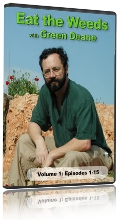
Foraging DVDs make a good gift to watch during the lifeless months of winter.
Though your foraging may drop off during Covid-19 travel bans it’s a great time to study wild edibles with my nine DVD set. Each DVDs has 15 videos for 135 in all (that’s $1 a video.) They make a great gift. Order today by the set or individual videos. Some of these videos are of better quality than my free ones on the Internet. They are the same videos but many people like to have their own copy. I burn and compile the sets myself so if you have any issues I handle them personally. There are no middle foragers. I also made more to cope with the quarantines and replace lost class income. To learn more about the DVDs or to order them click here.
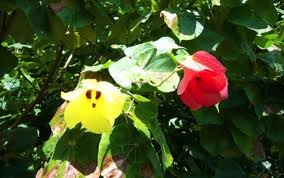
Mahoe blossoms change color. Photo by Green Deane
Foraging is treasure hunting for adults. While waiting for a bike to be assembled in Orlando I took a walk around the neighborhood of College Park. It had the usual species one would expect to find in this part of Florida this time of year except for a Variegated Mahoe. This is a common south Florida landscape tree. There is one where my classes are held in West Palm Beach, 189 miles to the south. Related to the hibiscus the young leaves, inner bark, tender roots, and blossoms are edible. In fact the blossoms start the day yellow and turn red in the afternoon. I can only guess what one was doing alive in the Orlando area though there is another one in Mead Garden. As the College Park example was a foot through at the base perhaps it was planted way back in the last century when the winter temperatures were warmer. You can read about the Mahoe here.
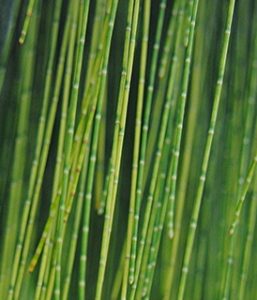
The rings are the leaves on the Australian Pine.
It’s time to mention the Australian Pine again, which really isn’t a pine. Indeed there are many plants called “Pine” that are not pines… the Australian Pine, the Norfolk Pine, the Screw Pine. As they are not in the Pinus genus they usually are not used like true pines. As for the Australian Pine it is more closely related to the oaks but does have some edible parts, barely. You can drink the red sap. The dry sap also turns into a gum that is edible. Young cones, seeds and branchlets are also edible cooked but you have to be really hungry. The tree is also an indicator of fresh water, even on the shore. Where they grow there will be fresh water, either floating on top of salt water or in a swale. And, you can dig up the shallow roots for water. The tree has been in this part of the world for about 170 years. As with many invasive species the U.S. Department of Agriculture had a hand in their proliferation. Locally it was in Palm Beach by 1921 and within 20 years it was the most planted tree in Florida. Within 10 years after that ordinances were being passed to control it. You can read about the invasive species here.
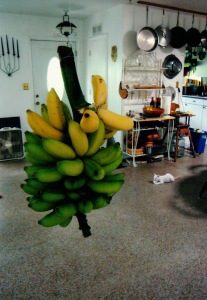
Bananas ripening inside. Photo by Green Deane
The presence of an ocean moderates temperatures so bananas can live to two years old and fruit. You can eat the purple blossom, the unripe and ripe fruit, and the inner pith of the stalk. They way you harvest bananas is to keep an eye on them. When one begins to turn from green to yellow you cut the entire branch off (called a hand) and take it inside the house. I used to hang them from the ceiling by a plant hanger. They will ripen slowly inside from one end to the other. That’s way you protect them from rotting and insects and you get most of the bananas for yourself. Whether the world will run out of bananas is difficult to tell. They are mostly all clones and are being attacked by a similar “Panama” fusarium disease as in the 1950’s. The variety of banana we eat today — Cavendish — is different and less tasty than the commercial one when I was a kid, which was the Gros Michel aka the “Big Mike.” Now a new fusarium disease threatens to wipe out the “Cavendish.” To read more about bananas click here.

Green Deane Forum
Want to identify a plant? Perhaps you’re looking for a foraging reference? You might have a UFO, an Unidentified Flowering Object, you want identified. On the Green Deane Forum we — including Green Deane and others from around the world — chat about foraging all year. And it’s not just about warm-weather plants or just North American flora. Many nations share common weeds so there’s a lot to talk. There’s also more than weeds. The reference section has information for foraging around the world. There are also articles on food preservation, forgotten skills from making bows to fermenting food. Several hard-to-find books are there page for page. Recent posts this week include Spring 2020 Plantings, Light Purple Flowers and Fuzzy Leaves, Red Blossoms Hanging Down, Edible Privacy Fence, Tendrilizing, Calculating COVID-19 Mortality Rate, Nettle Spanakopita, Pawpaws Starting Early? What are those White Blossoms, Brazilian Pepper Revisited, Palmer Amaranth, In The Loop, Tomatoes: A Fruit First, a Vegetable Second, and Butterweed: Annual Warning. You can join the Forum by going to the upper right hand top of this page.
 Donations to upgrade EatTheWeeds.com have gone well. Thank you to all who have contributed to either via the Go Fund Me link, the PayPal donation link or by writing to Green Deane POB 941793 Maitland FL, 32794. There are many needs left such as expanding the foraging teacher page and the page on monotypic edibles. There’s always something and such things get more complex and expensive every year.
Donations to upgrade EatTheWeeds.com have gone well. Thank you to all who have contributed to either via the Go Fund Me link, the PayPal donation link or by writing to Green Deane POB 941793 Maitland FL, 32794. There are many needs left such as expanding the foraging teacher page and the page on monotypic edibles. There’s always something and such things get more complex and expensive every year.
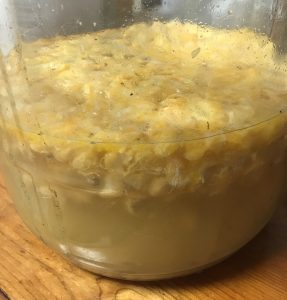
Tangerines in primary fermenter. Photo by Green Deane
With a bit more time on my hands I’ve been scrounging the neighborhood for material for wine. I have two small batches going, Loquat and Tangerine. Between them that should produce about 10 bottles of wine some months from now. I haven’t made a lot of wine in the last decade. Before that I brewed several hundred gallons per year of wine and beer (all legal in Florida. Check you local laws.) When I was a kid I made two five-gallon batches of beer using cooking malt and soft bread yeast (was sold in a soft, refrigerated cake form.) Then I moved on to Dandelion wine. That was probably the easiest wine I ever made because the blossoms were so plentiful and easy to collect (in Maine.) Below the for-profit professional level making wine is fairly easy. The “recipe” doesn’t vary much: So much fruit, so much sugar, yeast, and process and of course keeping things very clean unless you want vinegar which is a different process. (My vinegar video is here.) Within that amateur winemaking range there’s a lot of variability. You can control the process as much as you want from only wild yeast and no added sugar to manipulating the fruit and using various additives. There’s a lot of leeway. I also found one of my primary fermenters cracked so I had to use a glass bottle for the first pass. I don’t think I have a video on making wine but I do have one on making a one-week hard cider.
This is weekly newsletter 399, If you want to subscribe to this free newsletter you can find the sign-up form in the menu at the top of the page.
To donate to the Green Deane Newsletter click here.


Thanks ever so much. You work so hard!
Billy
Deane, hi
Turk here. not sure if my E’s reach you.
(I receive your newsletter just fine.)
Question RE: Turkey Tail.
Been makin’ tea from my own, off a down water oak.
Now they’re gettin’ dry and dusty (spores?)
Can I continue to use them ?
Thanks,
Turk
Yes I’ve to bid Green lots of thanks not only because of promptly receiving the current issue of always lovely Eattheweeds ,but of the useful contribution specially in combatting the world wide human foe. Green has done much concerning matters on fermentation, wine& ethanol – the high demand for sanitisers is appreciated. Finally, according to our prophet peace be upon him& the other prophets ,” He who does not thank people, does not thank almighty God.
For recieving eattheweeds, & for contribution in making ethanol by fermentation& wine – as needed today all over the world in combating crona covid 19, herein I thank you. According to our profit peace be upon him & other profits, ” He who does not thank people, does not thank God .”
I can’t seem to find the problem you are referring to in the article. Can you give me more information?
For all to stay at home, wash well with sanitizer,and worship and pray God during bowing and kneeling with forehead for long time. Oh God help us. You are our only resort.
The following google reference relevant to covid19- i ask you to include in comments of the latest eattheweeds so that it may be useful to readers ( oral allergy syndrome – pollen and cross – reacting foods. This reference has been taken by me during my reading your articel on BANANA.
Hi,
happy to have found you.
In the strawberry guava can you see the fruit fly eggs? Are they harmful if eaten? What is the best way to propagate one? I noticed there was one bush with fruit and one without. Are there male and female plants? How do they pollinate. I was thinking of planting mine in a pot because you said they are invasive.
I am on Sanibel.
Thanks,
Frances
I never found insect eggs in the fruit just larva.They are self-pollinating.